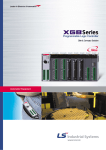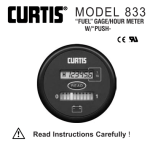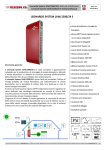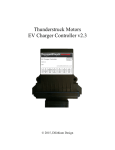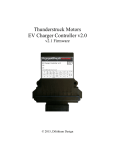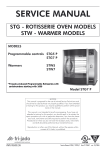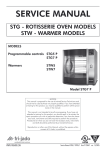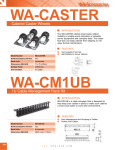Download Curtis 1620S User's Manual
Transcript
MODEL
manual
1620
SWITCH MODE
BATTERY CHARGER
Applicable to 230VAC units only
®
Before charging, read
instructions carefully!
IMPORTANT SAFETY INSTRUCTIONS
SAVE THESE INSTRUCTIONS
Read the Operating Instructions carefully before using the Model 1620 charger.
1. WARNING – Failure to install and operate the charger in accordance with these instructions may result in damage to the charger or injury to the operator.
2. WARNING – Never place the charger directly above or below the battery being charged. Gases or fluids from the battery will corrode and damage the charger. Locate the charger as far away from the battery as the output cable allows.
3. WARNING – Explosive gases may result from charging. Provide adequate ventilation during charging. Prevent flames or sparks.
4. WARNING – Do not attempt to open the charger. There is risk of electric shock even if the charger is unplugged. No user serviceable components inside.
5. WARNING – If safe operation of the charger can no longer be ensured, stop and secure it against operation.
6. WARNING – If the supply cord is damaged, it must be replaced by a qualified person in order to avoid hazard.
7. WARNING – Never charge a frozen battery.
8. WARNING – To reduce the risk of injury, charge only lead acid or gel cell type batteries. Do not attempt to charge any other type of chargeable or non-rechargeable battery; these batteries may burst, causing
personal injury and damage.
9. WARNING – To protect the operator from serious injury and the battery from damage, Curtis recommends using a fast blow fuse rated for a minimum of 32V and a maximum of 30A between the battery and the charger.
10. CAUTION – It is recommended that you disconnect the AC power cord before connecting or disconnecting the charger to the battery.
11. CAUTION – Not intended for outdoor use.
12. CAUTION – Charger surface may be hot while plugged in and for a period of time thereafter. 13. CAUTION – Units must have at least 30mm of clearance on the vented ends of the charger. Do not restrict ventilation to the charger in any way. Failure to do so may result in degradation of charge
performance.
14. CAUTION – If charger failure or malfunction may cause personal injury or material damage, use
additional safety measures such as limit switches, guards, etc.
15. CAUTION – Failure to install and use the charger in accordance with these instructions may impair the protection provided by the charger and may void the manufacturers warranty.
16. CAUTION – Never plug a 120VAC only charger into a receptacle not rated for 120VAC nominal.
17. These chargers are suitable for use with all 24V, 12 cell, rechargeable lead acid/gel cell batteries ONLY.
It is intended for use with batteries rated up to 200 amp-hours.
18. This charger was manufactured and tested according to the applicable technical standards referenced herein. It complies with safety regulations as shipped from the factory.
19. Be sure to read and understand all of the battery manufacturer’s instructions, such as removing or not removing cell caps or recommended rate of charging, prior to using this charger.
Warranty
Two Year Limited Warranty (see terms of sale for specifics).
All specifications subject to change without notice.
CONTENTS
1. Model Encodement.............................. page 1
2. Technical Specifications................... page 1
3. Installation.............................................. page 7
4. Operation.................................................... page 8
5. Troubleshooting.................................. page 9
6. Maintenance............................................ page 10
Curtis 1620 Manual
1
2
MODEL ENCODEMENT
1620uv-www/xx/yy-zzz
1620
u
v
- www /
Input
Voltage
Output
Voltage
F
Fan
cooled
S
Sealed
120
120VAC
24
24VDC
Model Cooling Sealing
2.1 Electrical
xx
/
230
230VAC
yy
Output
Current
- zzz
Series
Number
20
001
20 Amps Consult Factory
for
additional options
TECHNICAL SPECIFICATIONS
Input:
Voltage:
Frequency Range:
Input Current:
120VAC models
100-132VAC
57-63Hz
12Arms max. @ 100VAC/60Hz
Output Voltage:
Output Current:
Output Max. Power:
230VAC models
180-264VAC
47-63Hz
4.5Arms max. @ 180VAC/50Hz
24VDC, nominal
0-20A
580W
2.2 Mechanical
Case:
Aluminum alloy, black finish
End caps:
Polycarbonate, black
Dimensions (mm):
292L x 165.0W x 73.0H
Weight:
2.8kg
2.3 Connections
page 1
AC Power Inlet:
Programming Port:
Motor Controller Inhibit: IEC 320/C14
Molex 39-01-2040 For use with Curtis Instruments’ Model 1311 handheld programmer only.
Pin
Function
1
Rx
2
SEC_RTN
3
Tx
4
+12V
Molex 39-01-4030 60mA max. current.
Pin
Function
1
See wiring diagram 1
2
No connection
3
See wiring diagram 1
DC Power Output:
2 x M5 studs (max torque 2.2Nm).
Pin
Function
+
B+ output
–
B– output
Curtis 1620 Manual
J2-1
J2-2
J2-3
100V max., 60mA max.
Wiring diagram 1.
2.4 Environmental
Operating temperature:
Storage temperature:
Humidity: Shock: Vibration: Protection:
0°C to +50°C
-40°C to +85°C
95% non-condensing at 38°C
SAEJ1378, 55g pulse at 9-13ms
5g rms, 5-500 Hz, 2 hrs. per axis
IP-54, including fan
2.5 Compliance
Radiated Emissions:
Conducted Emissions:
EN50082-1-1997
ESD:
Radiated Immunity:
FCC Part 15, Class A
FCC Part 15, Class A
—
—
—
Electrical fast transient:
Surge Immunity:
Conducted Immunity:
Power Frequency Magnetic Field:
Voltage dips and sags:
Harmonics:
Voltage fluctuations (flicker)
Safety
—
—
—
—
—
—
—
—
EN55011, Class A
EN55011, Class A
X
EN61000-4-2:1995
EN61000-4-3:1995 +
A1:1998
EN61000-4-4:1995
EN61000-4-5:1995
EN61000-4-6:1996
EN61000-4-8:1993
EN61000-4-11:1995
EN61000-3-2:2000
EN61000-3-3:1995
EN60335-1:1995
EN60335-2-29:1997
2.6 Battery Types
This charger is suitable for use with all 24V, 12 cell, rechargeable lead acid
batteries with capacities of approximately 200Ah.
2.7 Charge Cycle Profile
The Model 1620 charger provides three different charge profiles: IVa (Off Mode,
see Figure 1), I1VI2a (Equalize Mode, see Figure 2) and IV1V2 (Float Mode, see
Figure 3).
For definitions of the variables mentioned in this section, refer to Table 1.
Curtis 1620 Manual
page 2
2.7.1 – End of Charge Mode
Figure 1. Charge profile for End of Charge Mode
Figure 1 defines the charge profile for the End of Charge Mode. As long as the
battery voltage (V) is above Undervoltage Lockout Level (Vuvlo), charging will
start after short delay of about 6 seconds. For battery voltage between Vuvlo and
Vlv, charge current will be limited to lower value (Ilv) in order to prevent gassing
damage to the batteries. Good batteries will quickly increase voltage above Vlv
and the 1620 will increase current to Constant Current value (Icc).
This is beginning of a bulk charge, which typically returns 80% of the charge. At
the end of bulk charging, battery voltage has reached Constant Voltage level (Vcv)
and the charger will maintain the voltage by reducing the current (I) gradually.
When the current drops to Icv, charging will stop, at which point the charger has
returned 105-110% of the Ampere-hours discharged.
If the battery is not used, its voltage will slowly drop due to self-discharging.
When battery voltage reaches Restart Voltage (Vrst), the 1620 will turn back on
and fully charge battery again.
page 3
1
Curtis 1620 Manual
2.7.2- Equalize Mode after End of Charge Mode
Figure 2. Charge profile for Equalize Mode
Figure 2 defines the charge profile for the Equalize Mode. After going through
bulk charge and Constant Voltage modes, the charger will reduce its output current to Top-Off Current (Ito) until one of the two possible outcomes occurs:
(1) Battery voltage rises to Equalize Voltage (Vequ) or
(2) Equalize Time-Out (Tto) is reached.
Once one of these two possibilities occur, charging will stop and the 1620 will set itself
to Off Mode; the charger remains in standby until restart voltage (Vrst) is reached.
Curtis 1620 Manual
page 4
2.7.3 - Float Mode
Figure 3. Charge profile for Float Mode
Figure 3 defines the charge profile for the Float Mode. In this mode of operation,
batteries are maintained at full charge. In addition to maintaining full charge, the
charger can support a load current – as long as the combined load current and
battery charging requirements do not exceed the output current defined in the
Constant Current setpoint (Icc, default value of 20A in the Basic Mode).
In this mode of operation, the charger will go through bulk charge and Constant
Voltage modes as previously described. It then goes into standby until the battery
voltage drops 0.4V below the Float Voltage (Vfloat, default value of 26.8VDC in
Basic Mode) setpoint. The charger will then reactivate and maintain float voltage
as long as the current requirement is above 2A. If current drops to 2A, the charger
will again enter standby mode. The charger will continue this cycle of standby/
reactivation until power is removed or until the Model 1311 programmer is connected.
page 5
1
Curtis 1620 Manual
2.8 Indication Lights
The charger features built in diagnostics. Refer to the table below to interpret the
flashing of the green and yellow indicator lights.
Flash Pattern
Yellow on, Green on
Yellow on, Green blinks1
Yellow and Green blink1 together
Mode
Standby Indicator 1
Charging
Standby Indicator 2
Yellow and Green blink alternately
Yellow blinks1, Green on
Programming
Standby Indicator 3
Yellow blinks1, Green off
Error
Yellow blinks2 once,
2 seconds off, repeats, Green off
Yellow blinks2 twice,
2 seconds off, repeats, Green off
No indicators on
Error
1 – 0.5s on, 0.5s off
2 – 0.5s on
Curtis 1620 Manual
Error
Off/Error
Charge Status
Charge done, ready to use.
Charging normally.
Charge cycle has not started,
refer to troubleshooting section.
1311 programmer connected to the unit.
End of Charge (Veoc) voltage reached.
Charge done, ready to use.(200s delay)
Charge cycle stopped,
refer to troubleshooting section.
Charge cycle stopped,
refer to troubleshooting section.
Charge cycle stopped,
refer to troubleshooting section.
Charger is unplugged, otherwise
refer to troubleshooting section.
page 6
3
page 7
1
INSTALLATION
3.1 Unit should be securely mounted to a flat surface.
3.2 The power cord to the IEC 320/C14 connector should be of the appropriate gauge to carry a 15A current, for the cable’s length, to meet the requirements
of applicable electrical codes. The power cord must meet IEC requirements with a minimum cross section of 1.5mm.
3.3 The wires between the charger output and the battery should be of the appropriate gauge to carry a 20A current, for the cable’s length, to meet the requirements of applicable electrical codes. An inline fuse (32V min. 30A max.) is recommended to protect against accidental battery short circuit.
3.4 A minimum of 30mm clearance should be provided at each vented end of the charger.
3.5 Charger should not be installed in locations which restrict airflow to the unit.
3.6 The circuit supplying power to the charger should be rated at a minimum of 15A for a 120VAC circuit, or for 5A for a 230VAC circuit.
Curtis 1620 Manual
4
OPERATION
4.1 Charging the battery
4.1.1 If using the motor speed controller inhibit, and a Curtis motor controller is present, connect the Motor Controller Inhibit connector to the
appropriate connector on the motor speed controller.
4.1.2 Connect the (–) terminal of the charger to the (–) terminal of the battery.
4.1.3 Connect the (+) terminal of the charger to the (+) terminal of the battery.
4.1.4 Plug the charger into an appropriate AC power source.
4.1.5 Charging is complete when a steady green indicator light is seen next to the battery symbol on the charger. Unplug the charger from the wall and
disconnect the charger from the battery, removing the connection to the (+) terminal first.
4.2 Programming Options
Curtis chargers do not use the 1311’s Monitor, Faults, or Functions Menus. The
Information and Programmer Setup Menus operate as described in the 1311’s
instruction manual with the exception of the Serial Number submenu in the
Information Menu – this field is filled with a default value of 12345678.
The 1620 offers two levels of programmability, Basic and Advanced. The program features are accessed by connecting a Curtis Model 1311 handheld programmer to the Programming port. Programming in Basic Mode involves setting
battery type (Flooded or Sealed Lead-Acid) and End of Charge Mode (charge
profile), while Advanced Mode offers flexibility of changing the most important
parameters of the charger for optimum charging of almost any Lead-Acid based
battery. Of course, selecting the Factory Default option restores the charger settings to the default values it left the factory with. This option can be invoked at
any time.
Variable parameters, limits, default settings, accuracy and descriptions are listed
in Table 1.
4.3 Programming the charger
Note 1: Connecting the Model 1311 handheld programmer to the charger will
cause the charger to enter standby mode while connected. The charger will reset
and resume normal operation upon removal of the 1311.
Note 2: The Model 1311 handheld programmer is available with different connectors. Be sure to use a 1311 with the 4 pin Molex connector. Conact a Curtis
sales office for assistance.
4.3.1 Attach the programmer to the 4-pin Molex connector, between the
indicators. The yellow and green indicators will blink on and off simultaneously, indicating that the charger is in programming mode.
4.3.2 Configure the programmable parameters defined in Section 4.2.
4.3.3 Once the programmable parameters have been defined, disconnect the 1311 programmer from the charger. The charger will reset and resume normal operation.
Curtis 1620 Manual
page 8
5
TROUBLESHOOTING
The following checklist should help you to troubleshoot any problems with the
charger. Make sure to observe all safety instructions provided on the unit and in
this manual.
Flash Pattern
Indication
Solution
Yellow and Green
blink1 together
No battery
or reverse polarity
Battery may be disconnected from
charger or connected back wards.
Battery may be severely discharged.
Lower Vulvo in the software setting.
Battery damaged. Replace battery.
Yellow blinks1,
Green off
Charger overvoltage
Battery may have been disconnected before the end of charge; reconnect the battery and reset the charger3. (or wait 200 seconds).
Battery manufacturer’s rated voltage may exceed charger’s rating. Verify rated battery voltage.
Yellow blinks2 once,
2seconds off, repeats,
Green off
Not reaching VCV
within Tcmax.
Battery manufacturer’s rated capacity may
exceed charger’s rating. Increase Tcmax,
increase Icc, or reset the charger3.
Battery may be damaged or old. Replace battery.
Yellow blinks2 twice,
2 seconds off, repeats,
Green off
Not reaching Vlv
within Tlv
Battery manufacturer’s rated capacity may
exceed charger’s rating. Increase Tlv, decrease
Vlv, increase Ilv, or reset the charger3.
Battery may be damaged or old. Replace battery.
No indicators on
No power or
Charger may be unplugged. Check for damaged charger
AC power. Charger may be damaged.
Consult manufacturer for repair or return.
1 – 0.5s on, 0.5s off
2 – 0.5s on
3 – Resetting the charger: Remove and restore power to the charger. Charger may be damaged if operation does not resume after AC power is recycled (light should go off approx. 20sec after power is removed and then charger can be
restarted). Alternately, connect the Model 1311 handheld programmer to the charger until it has completed its boot up phase, then disconnect the programmer.
page 9
1
Curtis 1620 Manual
6
MAINTENANCE
Excess dirt or grime may be removed from the unit by wiping it with a cloth
dampened with water.
Although Curtis chargers are equipped with a fan designed to last the life of the
charger, exposure to harsh environments – such as dusty condition, grease, chemicals, etc. – may impair the effectiveness of the fan. If the operation of the fan is
noticeably degraded, Curtis recommends an immediate replacement of the fan
with Curtis Part Number 17603351, 1620 Fan Assembly.
6.1
Replacing the fan:
6.1.1. Disconnect the charger from power and from the battery.
6.1.2. Remove the fanguard by simultaneously pushing in the retaining clips on either side of the fan and gently pulling the fan guard away.
6.1.3. Unplug the fan assembly, noting the fan orientation, air flow direction,
and wire routing.
6.1.4. Remove the fan assembly.
6.1.5. Replace with new fan assembly , being sure to match the orientation and airflow direction of the previous fan, and plug the fan in. Route the fan wires as previously located to avoid pinching the wires.
6.1.6. Replace fan guard and push until a click is heard. Verify both retaining clips have fully engaged.
Curtis 1620 Manual
page 10
Table 1. Programming Parameters
Programming mode
BASIC MODE 2
Description
Programming
Limits
1 or 2
Default Value
Increment
1
1
1, 2, or 3
1
1
Constant Current (Icc)
10-20A
20A
0.5A
Constant Voltage Level
(Vcv)
26-30V
29V
0.1VDC
Low Voltage Current
(Ilv)
2-10A
6A
0.5A
Top-off current (Ito)
2-10A
6A
0.5A
End of charge ("soft" overvoltage)
(Veoc)
29-35V
31VDC
0.1V
EoC Threshold (Icv)
2-20A
4A
0.5A
Restart Voltage (Vrst)
22-28v
26VDC
0.1V
0-26VDC
24VDC
0.1VDC
4-21VDC
5VDC
0.1VDC
Equalize Voltage (Vequ)
29-33V
31VDC
0.1VDC
Float Voltage (Vfloat)
25-30V
26.8V
0.1VDC
Low Voltage Timeout (Tlv)
1-10hrs
1 hour
1 hour
Equalize Timeout ( Tto)
0-5hrs
2 hours
1 hour
Maximum Charge Time
(Tcmax)
2-36hrs
16 hours
1 hour
Battery Type
End of Charge
ADVANCED MODE
Bulk Charge Threshold
(Vlv)
Low Voltage Lockout
(Vuvlo)
1 Accuracy is calculated as percentage of the maximum setting.
2 Items in bold are as they appear in the display of the 1311 handheld programmer.
page 11
1
Table 1. Programming
Curtis 1620 Manual
Accuracy*
Definition
1-FLA: Float voltage is set to 26.8V, Constant voltage set to 29V.
2-SLA: Float voltage set to 27.6V, Constant voltage to 29.4V
1-OFF: Charger goes into standby. Charger will cycle to recharge the battery as
determined by Vrst and enter standby at the end of the charge cycle.
2-EQUALIZE: Charger adjusts its output current to Ito, and drives the battery to Vequ.
It has the time allotted by Tto to do this or a fault will occur.
3-FLOAT: Charger goes into standby upon entering EoC Mode, and remains in standby
until the battery reaches Vfloat. At this point the charger turns on and maintains Vfloat
until power is recycled.
+/- 3%
Current used to charge the batteries during normal (bulk charge) operation. This current
is used when the battery voltage is greater than, or equal to Vlv, and less than Vcv.
+/- 1%
Battery voltage maintained by charger during bulk charge. This voltage is maintained by
continuously dropping the output current, until Veoc is reached.
+/- 5%
Current used to recover deeply discharged batteries; this current is used when the battery
voltage is greater than or equal to Vuvlo, and less than Vlv.
+/- 5%
Current used to Equalize the batteries.
+/- 1%
Charger goes into "soft" overvoltage mode, from which it recovers when battery voltage
drops below Vrst.
+/- 3%
Current at which the charger transitions to EoC mode.
+/- 1%
Used when EoC Mode is EQUALIZE or OFF; the battery voltage at which charger
automatically turns on and recharges the battery. Charger must be in stand by mode when
this voltage is detected; the charger will charge the battery until it reaches Vcv and then
enter stand by mode.
+/- 1%
Battery voltage at which the charger switches from Ilv to Icc.
+/- 1%
Battery voltage below which the charger will not turn on.
+/- 1%
Used when EoC Mode is EQUALIZE. The voltage at which the EQUALIZE mode is
ended, unless the mode ends by reaching Tto.
Used when EoC Mode is FLOAT. Once the battery voltage drops to this set point, the
charger will turn on and stay on, maintaining this battery voltage.
+/- 1%
+/- 5min
If battery does not reach Vlv within this timeout period, an error is indicated.
+/- 5min
Used when EoC Mode is EQUALIZE. Number of hours charger is kept at equalization
current, unless the mode is ended by reaching Vequ.
The maximum amount of time the charger has to complete a charge cycle and enter
standby mode. Failure to complete charge in the allotted time will result in a fault mode.
+/- 1hr
g Parameters
Curtis 1620 Manual
page 12
CURTIS INSTRUMENTS, INC.
200 Kisco Avenue, Mt. Kisco, NY 10549 • Tel: (914) 666-2971 • FAX (914) 666-2188
www.curtisinst.com
is a registered trademark of Curtis Instruments, Inc.
Specifications subject to change without notice
© 2005 CURTIS INSTRUMENTS, INC.
53033 REV E 12/07

















